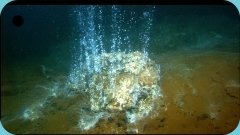Lots of activity
Last night, the science team made a discovery that got everyone excited. While exploring the underwater volcano Kolumbo, northeast of Thera, they saw a very active field of hydrothermal vents. The video pictures from the ROV Argus revealed tall chimney structures with gasses bubbling out. At one point, the camera view was filled with bubbles! Around the vents, colorful bacterial mats covered the sea floor.
 Unfortunately, there was also a problem. For several days, the ship's bow thruster has been broken. Without the bow thruster, it is hard to keep the ship in one location. The wind and water can push the ship in different directions which makes it very difficult to use the ROVs to at the vent site. Without the bow thruster, the team has been able to use Argus, which is connected to the ship by a strong cable. However they have not used Hercules, which can drive around and is affected more by the movement of the ship.
Unfortunately, there was also a problem. For several days, the ship's bow thruster has been broken. Without the bow thruster, it is hard to keep the ship in one location. The wind and water can push the ship in different directions which makes it very difficult to use the ROVs to at the vent site. Without the bow thruster, the team has been able to use Argus, which is connected to the ship by a strong cable. However they have not used Hercules, which can drive around and is affected more by the movement of the ship.


Today, everybody has new energy. They are excited about the new vents, and the excitement shows in the live Immersion Presents broadcasts. We hope you are enjoying the shows.
View more photos of the hydrothermal vents.
Todd Viola
Immersion Presents